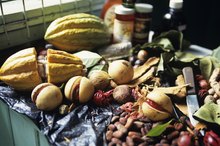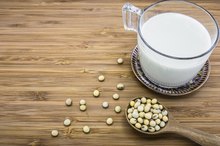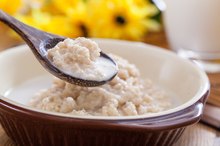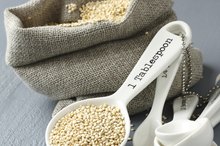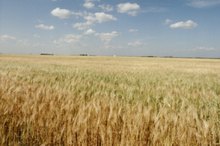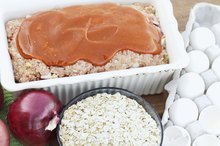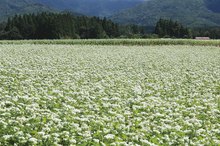Raw Food Diet and Oats
A raw food diet, which is usually vegetarian or vegan, consists of completely raw or slightly heated vegetables, fruit, nuts, seeds, sprouted grain, herbs and sea vegetables. It’s sometimes called a living food diet, because the live enzymes in the food remain intact in uncooked food. Raw foodists contend live food is a purer, better source of energy. A number of raw food recipes call for oats. Before you embark on a raw food diet you need to consult with your physician. To maintain health you need to consume all macro and micronutrients -- fats, carbs, protein, vitamins, minerals -- and you may need guidance when starting a raw food diet. This is especially true if you are being treated for any existing medical conditions.
Identification of Raw Food
Although the food in a raw food diet can be either chopped, shredded, blended, frozen, dehydrated, soaked, sprouted, pureed or juiced, a large majority of it is completely raw. Some heating is allowed, but food heated beyond about 120 degrees Fahrenheit is no longer considered suitably raw, because most of its live enzymes have been destroyed, according to Stephanie Tourles, author of "Raw Energy." Most commonly available oats don't qualify as raw because they're cooked during processing 1.
Types of Oats
Raw Food Diet & Bread
Learn More
Raw oats are generally available in two forms: oat groats and rolled oats. An oat groat is the whole, unbroken grain of the oat with just the outer hull removed. Because it’s raw and intact, you can sprout it. They’re also known as sprouted or Scottish oats. Rolled oats, or oatmeal flakes, are groats that have been rolled flat and dried. In most cases, rolled oats are steamed prior to being rolled, which means they’re not raw. However, raw rolled oats do exist, and are usually stocked in specialty health food shops.
- Raw oats are generally available in two forms: oat groats and rolled oats.
- In most cases, rolled oats are steamed prior to being rolled, which means They’re not raw.
Preparation of Oats
You can prepare most raw grains for easy digestion by soaking them for a set period of time, usually overnight. Rolled oats are an exception in that they don’t require soaking. Oat groat breakfast cereal recipes usually call for soaking, however, because it makes the groats tender, creamier and richer. To soak oat groats, place the amount you need in a large bowl and cover it with 2 inches of water and a paper towel. Let it soak overnight. Drain the excess water before using the oats.
- You can prepare most raw grains for easy digestion by soaking them for a set period of time, usually overnight.
- Oat groat breakfast cereal recipes usually call for soaking, however, because it makes the groats tender, creamier and richer.
Culinary Uses of Oats
Can I Drink Soy Milk on Raw Food Diet?
Learn More
Raw oats provide a starchy binding and add chewiness to raw recipes. Besides raw oatmeal, you can use them to make muesli, oat milk, parfaits, cookies, granola bars and bread. Recipes that call for unsoaked rolled oats usually also call for fruit juice or nut milk to soften the flakes. In many raw food recipes, you can use the leftover grain soak water in other recipes. However, you should discard the soak water from oat groats because it has a bitter taste.
- Raw oats provide a starchy binding and add chewiness to raw recipes.
- However, you should discard the soak water from oat groats because it has a bitter taste.
Health Benefits of Oats
Like steamed or cooked oats, raw oat groats or rolled oats are a good source of dietary fiber — including soluble fiber, which helps regulate blood glucose levels. Oats also contain significant amounts of B vitamins, potassium, iron, phosphorous, selenium, zinc, manganese and magnesium. According to naturopathic doctor Jeff Clark, author of “Raw Oats for Gastrointestinal Health,” regular intake of raw oat milk can reduce bowel fungus and promote the growth of healthy intestinal fauna 3.
Related Articles
References
- Raw Energy; Stephanie Tourles
- The Complete Book of Raw Food; Julie Rodwell, Editor
- Quick cooking oats. FoodData Central. U.S. Department of Agriculture. Updated 2019.
- Rebello CJ, Johnson WD, Martin CK, et al. Instant oatmeal increases satiety and reduces energy intake compared to a ready-to-eat oat-based breakfast cereal: A randomized crossover trial. J Am Coll Nutr. 2016;35(1):41-9. doi:10.1080/07315724.2015.1032442
- Mackie AR, Bajka BH, Rigby NM, et al. Oatmeal particle size alters glycemic index but not as a function of gastric emptying rate. Am J Physiol Gastrointest Liver Physiol. 2017;313(3):G239-G246. doi:10.1152/ajpgi.00005.2017
- Blaszczyk U, Duda-Chodak A. Magnesium: Its role in nutrition and carcinogenesis. Rocz Panstw Zakl Hig. 2013;64(3):165-71.
- Roager HM, Vogt JK, Kristensen M, et al. Whole grain-rich diet reduces body weight and systemic low-grade inflammation without inducing major changes of the gut microbiome: A randomised cross-over trial. Gut. 2019;68(1):83-93. doi:10.1136/gutjnl-2017-314786
- Pazyar N, Yaghoobi R, Kazerouni A, Feily A. Oatmeal in dermatology: A brief review. Indian J Dermatol Venereol Leprol. 2012;78(2):142-5. doi:10.4103/0378-6323.93629
- Hou Q, Li Y, Li L, et al. The metabolic effects of oats intake in patients with type 2 diabetes: A systematic review and meta-analysis. Nutrients. 2015;7(12):10369-87. doi:10.3390/nu7125536
- Whitehead A, Beck EJ, Tosh S, Wolever TM. Cholesterol-lowering effects of oat β-glucan: a meta-analysis of randomized controlled trials. Am J Clin Nutr. 2014;100(6):1413-21. doi:10.3945/ajcn.114.086108
- Dennis M, Thompson T. NCA stance on gluten-free oats. National Celiac Association. Updated 2018.
- American Academy of Allergy, Asthma & Immunology. Multiple food reactions: Oat, onion, tomato. Updated 2014.
- Mollo K. Why can I NOT tolerate GF oats?. National Celiac Association. 2019.
- Ingham B. The safety of raw oatmeal. Safe & Healthy: Preparing & Preserving Food at Home. University of Wisconsin-Madison. Division of Extension. Updated 2019.
Writer Bio
Based just outside Chicago, Meg Campbell has worked in the fitness industry since 1997. She’s been writing health-related articles since 2010, focusing primarily on diet and nutrition. Campbell divides her time between her hometown and Buenos Aires, Argentina.
